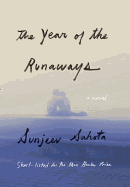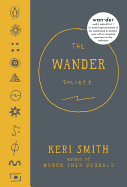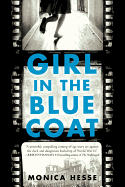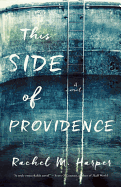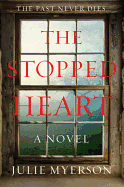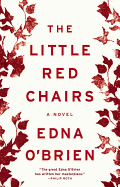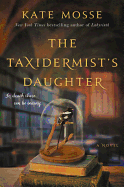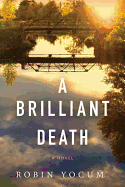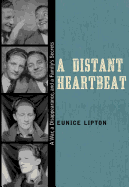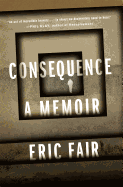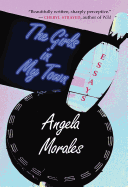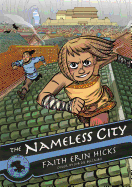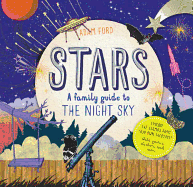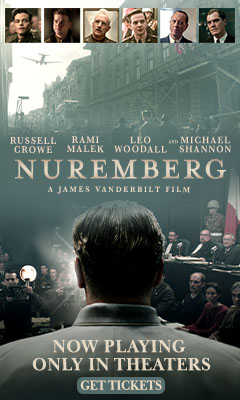Friday, April 8, 2016
With the return of spring comes the return of many backyard birds intent on their habitual rituals of courting, nesting, egg incubating and fledging their young. Two new books from Houghton Mifflin Harcourt take close looks at the complex lives of numerous wild birds.
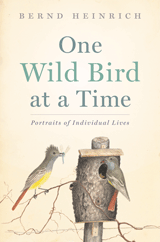 In One Wild Bird at a Time: Portraits of Individual Lives, Bernd Heinrich meticulously observes 17 varieties of birds that appeared near his cabin in the woods of Maine. He writes, "My watching birds of a particular species was usually stimulated by an anomalous observation that sparked a question." In these essays, he spies on flickers nesting in his cabin through a hole in his bedroom wall, studies how the weather and lack of a close food source forces vireos to abandon their clutch of eggs, ponders why male sapsuckers drum so loudly to attract a mate--coming to a plausible conclusion--and questions why broad-winged hawks line their nest with fresh fern leaves on a daily basis.
In One Wild Bird at a Time: Portraits of Individual Lives, Bernd Heinrich meticulously observes 17 varieties of birds that appeared near his cabin in the woods of Maine. He writes, "My watching birds of a particular species was usually stimulated by an anomalous observation that sparked a question." In these essays, he spies on flickers nesting in his cabin through a hole in his bedroom wall, studies how the weather and lack of a close food source forces vireos to abandon their clutch of eggs, ponders why male sapsuckers drum so loudly to attract a mate--coming to a plausible conclusion--and questions why broad-winged hawks line their nest with fresh fern leaves on a daily basis.
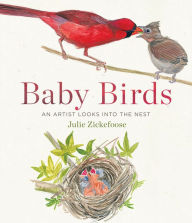 In Baby Birds: An Artist Looks into the Nest, Julie Zickefoose, a wildlife rehabilitator and artist, offers her observations and watercolor paintings of 17 species of baby birds. Zickefoose carefully watched nesting birds and managed in words and paint to capture the intricate, daily transformations they went through. She writes, "Some of the birds I would come to study and draw metamorphose from a writhing pink hatchling no bigger than your thumbnail to a flying bird in eleven days." She studies wrens, phoebes, cardinals, warblers, chickadees and other common birds found in backyards on a precisely timed daily basis, and her observations are enhanced by more than 400 watercolors. Both books complement each other as the authors give readers two different and intimate looks into the courting rituals, nesting habits and parenting skills of a multitude of wild birds. --Lee E. Cart, freelance writer and book reviewer
In Baby Birds: An Artist Looks into the Nest, Julie Zickefoose, a wildlife rehabilitator and artist, offers her observations and watercolor paintings of 17 species of baby birds. Zickefoose carefully watched nesting birds and managed in words and paint to capture the intricate, daily transformations they went through. She writes, "Some of the birds I would come to study and draw metamorphose from a writhing pink hatchling no bigger than your thumbnail to a flying bird in eleven days." She studies wrens, phoebes, cardinals, warblers, chickadees and other common birds found in backyards on a precisely timed daily basis, and her observations are enhanced by more than 400 watercolors. Both books complement each other as the authors give readers two different and intimate looks into the courting rituals, nesting habits and parenting skills of a multitude of wild birds. --Lee E. Cart, freelance writer and book reviewer
The Year of the Runaways
by Sunjeev Sahota
Sunjeev Sahota's The Year of the Runaways is a sweeping epic that weaves together the lives of three Indian immigrants in Northern England. Tochi is from the untouchable caste and is fleeing a violent past; Avtar is from a lower-middle-class family and wants to be able to provide for his parents and wife-to-be; Randeep is from an upper-middle-class household whose livelihood is threatened when Randeep's ailing father loses his job. Though the three come from disparate backgrounds, they have come to the U.K. seeking the same thing: opportunity.
In England, their lives are thrown together in haphazard, chaotic ways. They work together; they live together. They battle one another; they despise yet rely on each other. As immigrants working in England illegally, they share a fear of raids and feel the constant need for more money. As individuals, they face hard choices about who they were in India and who they want to be in England.
The Year of the Runaways is somewhat slow to build and can be confusing at times, which ultimately sets the tone perfectly for Sahota's nuanced exploration of what it is to feel out of place and bewildered by a new culture. Against this backdrop, Sahota brings his flawed and imperfect characters to life with stark, beautiful and unapologetic language--language that will ultimately pull readers into a story that is at once hyper-focused on the issue of Indian immigration to England and more broadly reflective of individual struggles to define an identity and a future. --Kerry McHugh, blogger at Entomology of a Bookworm
Discover: Three Indian immigrants struggle to shape their lives as they look for work in Northern England.
This Side of Providence
by Rachel M. Harper
Rachel M. Harper (Brass Ankle Blues) builds Arcelia's story through rotating narrators: her children, Cristo and Luz; their teachers; the family's landlord, nicknamed Snowman; and even her ex-husband in Puerto Rico. The effect is kaleidoscopic. Each shift in narrator reveals some new fact or detail that paints a complex and detailed picture of the difficulties in Arcelia's life. The story that emerges from this ever-evolving landscape is epic in scope, spanning such large topics as AIDS, the psychology of poverty, race, the education system and--perhaps most consistently throughout--what constitutes a family. "Family is the only thing that connects you to the world," Cristo is told. "Without that, you'd be flying around like a balloon some kid forgot to hold onto."
Arcelia's fight for this connection to the world (and her kids' fight, and their teacher's fight, and so on) in turn keeps This Side of Providence connected to our world; though Harper's novel is vast, it is never impersonal. And though it is dark, it is never without hope. --Kerry McHugh, blogger at Entomology of a Bookworm
Discover: A cast of narrators tells the story of Arcelia and her family as they struggle with poverty, racism and addiction.
The Stopped Heart
by Julie Myerson
Set in the quiet English countryside, Julie Myerson's The Stopped Heart is a creepy story filled with ghosts from the distant and near pasts, and the psychological twists and turns that accompany massive grief. In the present, Mary Coles and her husband, Graham, have endured a terrible blow and moved to the country to put their former life behind them. The cottage they purchase has been vacant for years, but still has many of the old fixtures and features: a steep, narrow staircase from the kitchen to the upstairs, a scrubbed-pine table, an old stone trough and water pump in the front yard. Here Graham hopes Mary can overcome her grief and begin to show an interest in living again--and in him. Left alone much of the time, though, Mary begins to sense something is not quite right with the house and property as she intuits and then sees snatches of people moving through the same space she occupies.
Myerson rapidly interweaves both the present and the past, jumping from one subplot to the other within paragraphs. This can be slightly confusing and a bit irritating as the tension from one scene is often cut short when she moves into the other storyline. However, the juxtaposition of both past and present is blended well, with high drama on both fronts as readers learn about the tragic events in Mary's life and what happened in the house's history. --Lee E. Cart, freelance writer and book reviewer
Discover: A haunted cottage in the English countryside is the setting for a psychological ghost story full of violence and tragedy.
The Little Red Chairs
by Edna O'Brien
Set mostly in the western Ireland town of Cloonoila after the collapse of Irish economy in 2008, Edna O'Brien's The Little Red Chairs begins with the arrival of mysterious Eastern Europe holistic healer and poet Dr. Vladimir Dragan, who senses in the town "that primal innocence, lost to most places in the world." Like many of the townspeople, Fidelma McBride, a woman whose husband finds her "elusive, like thistledown," is irresistibly drawn to the exotic, enigmatic Dragan. She's submerged in grief over two failed pregnancies and the loss of her clothing boutique in the economic meltdown. Her decision to engage in an affair with Vlad--in the hope it will result in a pregnancy she believes is impossible with her much older husband--is driven more by impulse than reason. When Dragan's past as a war criminal is exposed, Fidelma's suffering is Job-like in its devastation. She's forced to flee Cloonoila for London, where she becomes part of the community of the rootless, seeking a safe haven somewhere on the European continent.
O'Brien (Saints and Sinners) shifts effortlessly between a moving depiction of Fidelma's humiliation and search for personal redemption and the broader context of "migrants with babes in arms fleeing atrocities and heading for nowhere" into which she's thrust. On either level, she writes with surpassing empathy and insight. The story she tells in The Little Red Chairs is as ancient as national blood feuds dating back hundreds of years and as contemporary as today's Internet headlines. That timeless feeling is only enhanced by the melancholy wisdom she imparts about the inscrutability of human desire. --Harvey Freedenberg, attorney and freelance reviewer
Discover: An Irish woman's life unexpectedly intersects with sectarian violence in central Europe.
Mystery & Thriller
The Taxidermist's Daughter
by Kate Mosse
Set at the turn of the 20th century, The Taxidermist's Daughter, a brooding mystery by Kate Mosse (Labyrinth), starts with a superstition and progresses into a murder most twisted. Family secrets, madness and buried crimes make for a tense and chilling journey. In the Fishbourne Marshes of Sussex, old superstitions still have influence. Constantia Gifford discreetly follows her father one night, afraid he might get into trouble in his alcoholic stupor, and finds herself at a churchyard where a small gathering waits to see if an old legend is true. Folk wisdom has it that on St. Mark's Eve, specters of people fated to die in the coming year will appear and pass through the church doors. The mysterious woman she spies in the church's graveyard certainly is no apparition, for the next morning, Connie finds the woman's body in the marsh behind the house she and her father share. She discovers a wire from her father's taxidermy workshop embedded in the victim's neck, clearly used as a garrote.
Mosse builds a thick gothic atmosphere on a foundation of foggy, sucking marshland and the Victorian fad of stuffed birds and animals as decor, a trend not far in the past for Connie. While Connie's stuffing of a blackbird corpse demystifies the process of taxidermy, Mosse works a morbid angle with a killer who uses the tools of the trade against victims. Layers of questions, buried tragedies and looming corvid imagery form a dark tone perfect for mystery readers who want their whodunit served with a side of the grotesque and chilling. --Jaclyn Fulwood, blogger at Infinite Reads
Discover: An English taxidermist's daughter is drawn back to secrets in her lost memory when she finds a murdered woman behind her family's house.
A Brilliant Death
by Robin Yocum
In 1953, Amanda Baron and her presumed lover were killed in a boating accident on the Ohio River. Amanda's son, Travis, was only five months old at the time of her death, and his father, Frank Baron, a mean and violent man, tends to shut Travis up with his fists whenever he asks about his mom. Now a teenager, Travis is determined to get to the root of the rumors about Amanda and her alleged unfaithfulness, so he enlists his best friend, Mitchell Malone, to help him. Throughout their high school years, Mitch and Travis work on "Project Amanda" as they seek to uncover the truth about what happened so long before.
But then, in a shocking and eerie twist of fate, on graduation night in 1971, Travis, drunk after celebrating his status as salutatorian, drives off a bridge into the Ohio. Mitchell, crushed by the death of his friend, is left holding dangerous information about the fate of Amanda and has to decide what to do with it.
Part coming-of-age story, part cold-case mystery, A Brilliant Death does an excellent job of depicting life in an Ohio steel town. Robin Yocum (Favorite Sons, The Essay) has a knack for nuanced characters and spot-on dialogue.
The changing timeline as the story unfolds will keep the reader guessing about Amanda's fate until the end of the novel, and Yocum's deft portrayal of Travis and Mitch's friendship makes A Brilliant Death an altogether charming read, despite the dark story framing it. --Jessica Howard, blogger at Quirky Bookworm
Discover: Two boys growing up in an Ohio steel town try to solve a mystery from 16 years earlier.
Biography & Memoir
A Distant Heartbeat: A War, a Disappearance, and a Family's Secrets
by Eunice Lipton
Eunice Lipton grew up with an awareness of her uncle Dave that was specific and conflicted in emotional tone, and vague in points of fact. She knew he'd been in the Abraham Lincoln Brigade in the Spanish Civil War, and killed in action when he was 22. His brother Phil says, "Dave died for something. He was somebody." His brother Louis, the author's father, says he died for nothing. The author's mother says he was the nicest man she ever knew. A Distant Heartbeat asks: Who was Dave Lipton? Why did this respectful son lie, tell his parents he would be working at a hotel in the Catskills, and then go to Spain? What does his story have to offer history?
Dave Lipton (formerly Lifshitz) was a Latvian Jewish immigrant, immersed in leftist youth politics in 1930s New York City. Surrounded by peers whose convictions mirrored his, Dave was one of very few to join that foreign war. His niece, born after his death, grew up with only scraps of his life and death: the repeated refrains of family members--died for nothing, died for something--and a few photos discovered in her childhood. She speaks to surviving veterans and friends of Dave, travels to an International Brigades reunion in Spain, studies letters and archival photographs. She finds more questions: What is the nature and cause of familial betrayal? Who was Dave's mystery companion? In the end, Lipton's research and musings offer only fleeting conclusions about family and principles, in a precise, elegiac journey through history, family tensions and human drama. --Julia Jenkins, librarian and blogger at pagesofjulia
Discover: The author's uncle who was killed in the Abraham Lincoln Brigade in the Spanish Civil War is the subject of this inquisitive memoir.
Consequence: A Memoir
by Eric Fair
Raised by two schoolteachers in Bethlehem, Pa., along the Lehigh River, Eric Fair was a quiet, marginal student with a weight problem--one of "the kids who don't play sports and who buy their jeans in the husky section." Bullied, he sought shelter under the security of local cops patrolling his paper route and found refuge in the First Presbyterian Church. These early attractions to regimen and service manifest themselves throughout his life in a Presbyterian college, the U.S. Army, the private military contractor CACI, the NSA and seminary at Princeton. With a matter-of-fact, diary-like chronology, Fair's memoir, Consequence, tracks his gradual dissolution as military monotony, war, lies, guilt, marital stress, heart disease and alcoholism eat him alive. At the center of his disintegration is his role as an interrogator at the notorious Abu Ghraib prison near Baghdad.
Trained in Arabic by the army, he joined CACI for a lucrative assignment questioning and badgering detainees. "They tell us torture works. It always has. It always will." Fair describes the pain and intolerable prison conditions with some detachment, distancing himself from what he sees and does. However, the cruel "Palestinian chair" torture tool pushes him over the edge: "I am silent. This is a sin. I know it as soon as I see it. There will be no atonement for it." Although sometimes hard to read, Consequence is Fair's effort to confess and find that atonement--made more disturbing because he may be just one of many trying to understand the barbarity of Abu Ghraib. --Bruce Jacobs, founding partner, Watermark Books & Cafe, Wichita, Kan.
Discover: Eric Fair's frank memoir takes readers into the brutal interrogation rooms of Abu Ghraib and chronicles his consequent personal disintegration.
Essays & Criticism
The Girls in My Town: Essays
by Angela Morales
Angela Morales's The Girls in My Town is a collection of striking, lovely essays about her upbringing in Los Angeles. Vignettes paint a number of vivid scenes: her parents' appliance store, and the bowling alley where she went to escape it; an elementary school where the girls demanded to be allowed to wash dishes like the boys; a room where a grandmother lay dying, as generations of children ran laps in the yard outside; the community college where Morales teaches remedial English to an ex-con with a pitiable past. These portraits, and the characterization of a larger Los Angeles, form a sense of place that enlivens and colors the collection.
Themes include family, and the changes seen over generations, as in Morales's journey from daughter to mother, and in telling her grandparents' stories. Recurring patterns of teen pregnancy, violence against women and girls and the fear it inspires add a tone of somber musing. A series of animal characters--the pet dogs of the author's childhood, her own children's pet rats, a mountain lion in the hills--bring layers to a setting both urban and wild, becoming dreamlike on her pre-dawn bike rides. Morales has a strong, lyrical voice, and her essays and anecdotes can be humorous and loving and darkly meditative as they address family, beauty and violence, loss and love. In short, this collection is as varied, charming, stark and inspiring as life itself, in Los Angeles or anywhere. --Julia Jenkins, librarian and blogger at pagesofjulia
Discover: This collection of essays about a Los Angeles childhood is strongly rooted in place and universal in its themes.
Psychology & Self-Help
The Wander Society
by Keri Smith
For Keri Smith, author of Wreck This Journal, The Wander Society started with a used copy of Walt Whitman's Leaves of Grass. Inside she found mysterious scribbles and notes, including a thunderbolt with the words "Solvitur ambulando"--"it is solved by walking"--and under that, "The Wander Society." The unusual discovery piqued Smith's interest and she commenced investigating. The Internet provided little insight, but then she read Whitman's great work and began wandering with her eyes open.
Including examples of the posters, pamphlets, flyers and other media she found during her walks, Smith explains what she's come to understand the Wander Society to be: a group of individuals united by a desire to let their souls and minds roam. Through wandering, they heighten their creativity and experiment with the unknown.
The Wander Society offers suggestions for different approaches, like roaming with a purpose, meandering through libraries, listening while strolling and following/tracking. It provides directions for creating wandering materials, such as a walking stick or notebook, and a Wander Society station for connecting with other members. Smith has collected and organized the information in a way that inspires the reader to pack up the book and set out immediately.
Smith's enthusiasm illustrated through the marginalia she's scratched in the pages heightens the mysteriousness of the group, giving it an almost Dead Poet Society feel. Creative people of all walks of life--or those wanting to spark their imagination--should be energized by this wonderful resource. --Jen Forbus of Jen's Book Thoughts
Discover: An introduction to a secret society of creative thinkers who find inspiration in wandering.
Children's & Young Adult
Girl in the Blue Coat
by Monica Hesse
Girl in the Blue Coat by Washington Post journalist Monica Hesse (Stray; Burn) is not only an intriguing missing persons case, it's a poignant, wonderfully crafted story of love and loss, courage and redemption. In 1943 Amsterdam, 18-year-old Hanneke Bakker--so blonde and green-eyed someone said she's "the girl Hitler is dreaming of to put on his Aryan posters"--trades in the Dutch black market to support her family.
Making deliveries on her secondhand bicycle, Hanneke finds and sells goods such as tea and cigarettes that are hard to come by now that the German Green Police occupy the city. Hanneke's heart has hardened since her boyfriend, Bas, died at the hands of the Nazis she encouraged him to fight, and she misses her best friend, Elsbeth, who married into the Gestapo. So when elderly Mrs. Janssen begs her to find a missing Jewish girl named Mirjam Roodveldt, a 15-year-old she had been hiding in her pantry, Hanneke surprises herself by reluctantly agreeing to help: "That action is soft; I am practical. That action is hopeful; I am not," she thinks.
Hanneke soon becomes obsessed with finding clues about the girl in a blue coat "the color of the sky," who apparently disappeared into thin air. In the process, she becomes an accidental member of the "huge and sprawling" world of the Dutch resistance, struggling to make sense of both the horror and the heroism abundant in war. Hanneke does solve this mystery, and finds a way to heal. And she will touch readers' hearts, too. --Lynn Becker, blogger and host of Book Talk, a monthly online discussion of children's books for SCBWI
Discover: In this fine YA novel, the search for a missing Jewish girl in Nazi-occupied Amsterdam makes 18-year-old Hanneke an accidental member of the Dutch resistance.
The Nameless City
by Faith Erin Hicks; color by Jordie Bellaire
Thirteen-year-old Kaidu wonders if he's made a mistake. He's traveled to the Nameless City from his rural homelands to see the father he's never met and to start intense combat training--even though the boy prefers reading to fighting. Kaidu is a Dao, from the nation that has ruled the City for 30 years. But the valuable seaport has been conquered and re-named so often that the locals don't bother calling it anything, and see the Dao occupation as a temporary inconvenience. As he explores outside the palace walls, Kaidu becomes interested in Rat, an always-hungry street urchin who's amazingly skilled at sprinting across rooftops. They tentatively move toward friendship until Kaidu makes the mistake of romanticizing her rootlessness. "You don't know anything about me," Rat shoots back. "Don't say I'm lucky. Ever."
Writer-illustrator Faith Erin Hicks (Friends with Boys; The Adventures of Superhero Girl) does a wonderful job of showing contrasts in sharp jabs, as when Kaido wanders the City eating savory spiced meat, then turns to see a poor family scrabbling for food in a trash pile. The Nameless City, first in a trilogy of full-color graphic novels, blends acrobatic parkour, humor and cartoon sound effects (THUNK) with a complex web of alliances: tough-as-nails bodyguard Mura is a local--the Dao students she trains call her a skral, a slur--but she stays loyal to the Dao leader who gave her a job. Kaidu soon learns that they'll all need to think about loyalty differently unless they want yet another bloody war. --Ali Davis, freelance writer and playwright, Los Angeles, Calif.
Discover: Age-old rivals clash in Faith Erin Hicks's graphic novel, a fun and complex trilogy debut about the intersection of power, prejudice and friendship.
Stars: A Family Guide to the Night Sky
by Adam Ford
This playful guide to the cosmos will inspire everyone to gaze into the night skies. Along with a detachable fold-out star map of both the northern and southern hemispheres, there are activities, games and four pages of round, goofy stickers that say things like "Gas Aliens Rule."
Aimed at children just starting to think about the wonders of astronomy, Stars begins with "big picture" observations, such as why stars seem to disappear during the day, how these visible pinpricks of light can be enormous supergiants and how the moon gives off no light of its own, only reflecting the sun. It's space-trivia heaven. Did you know that all the planets are named for Greek or Roman deities except Earth? That shooting stars aren't stars? That the sun, at five billion years old, is considered "middle-aged?" That, somewhat dreamily, "You and I are made of stardust?"
Lively page design and friendly, artful, often comical illustrations draw readers in with punchy captions, such as a wry comment on the constellation Ursa Minor (Little Bear): "Looks more like a beaver than a bear." Brief, accessible sections on the planets, the Northern Lights, famous stars, the moon's landscape, constellations, black holes, the force of gravity and the life cycle of a star are thoughtful and perspective-bending. And Stars is tricked out with gadgets. A rotating spinner calculates Earthlings' weights on other planets. (This reviewer weighs about 50 pounds on Mars.) Add a "Space Pairs Game," which is like Concentration with planets and constellations, and this is rainy-day fun, too. A star is born! --Karin Snelson, children's & YA editor, Shelf Awareness
Discover: This inviting guide to the night sky, complete with detachable star chart, is sure to inspire budding astronomers.
| Advertisement nuremberg--now playing in theaters |


